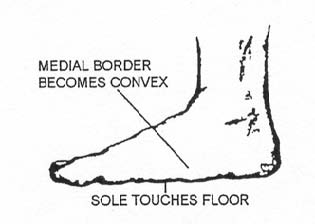The Musculoskeletal System
Lesson 2: Diseases and Disorders of the Feet
Section IV: Arthritis of the Feet
2-17
2-17. PES PLANUS (FLATFOOT)
Today, the term "flatfoot" is used to describe a foot that is normally flat from birth. (see figure 2-9). In years past, a flat foot was considered inferior, and the United States Army (US Army)routinely rejected men with flat feet as being unfit for military service.
Figure 2-9. Pes planus (flatfoot).
a. Dissimilarity of Flatfoot. Research reveals that individuals born with flat feet are well suited to marching in contrast to some people who have higher arches. The higher arched feet sometimes collapse under rigorous strain. The flat foot condition in which the heel has turned outward and the medial longitudinal arch has lowered can be a problem. The individual with this condition has not been born with low arches and may have foot problems such as weak ankles and/or collapsed foot ligaments.
b. Signs/Symptoms of Flatfoot. The signs and symptoms of flat feet include pain in the longitudinal arch and pain behind the medial malleolus. Treat with arch supports, warm footbaths, and aspirin.


